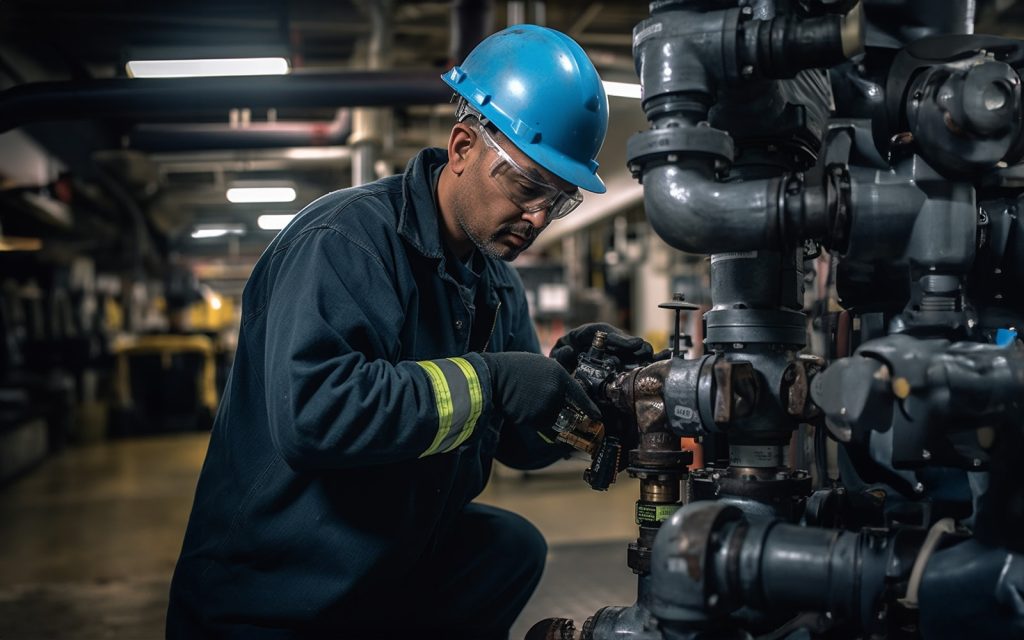Gas detectors are essential for ensuring efficiency and safety in various facilities. They serve as the silent watchmen, scanning the area for any hazardous gas leaks that might endanger the safety and well-being of the workforce. This article will dive into the importance of gas detection maintenance and clearly show proper gas detection procedures.
Gas detectors are vital in many different industries. These safety tools support monitoring various gases, including carbon monoxide, hydrogen sulfide, methane, and others, in oil and gas facilities, chemical plants, and manufacturing facilities. These gases all present different dangers. For instance, methane, while non-toxic, is highly flammable and can result in explosions when concentrations are high. Carbon monoxide, on the other hand, is a colorless, odorless gas that can cause sudden illness and death.
Importance of Gas Detector Maintenance
Gas detectors are essential for maintaining a secure workplace, particularly in fields with a high risk of gas leaks. Gas detector malfunctions or poor maintenance can have serious repercussions, from health issues to fatal accidents. For instance, undetected gas leaks were primarily to blame for the explosion at Formosa Plastics in Illinois in 2004, resulting in five fatalities and numerous injuries.
On the other hand, a properly maintained gas detector can quickly identify risks, allowing for the prompt implementation of appropriate measures. As a result, routine gas detector maintenance is not only advised but essential for operational effectiveness, worker safety, and regulatory compliance.
Particular gases carry particular risks. For instance, carbon monoxide limits the body’s ability to transport oxygen, whereas hydrogen sulfide can cause an immediate collapse with serious health effects or even death in high concentrations. These risks can be easily avoided thanks to prompt alerts from properly maintained detectors, underscoring the value of routine maintenance.
The tragic 2010 BP Deepwater Horizon oil spill is another incident highlighting the significance of maintenance. Bypassing the gas detectors on the rig prevented alarms from sounding, which caused an explosion that killed 11 workers and resulted in a major environmental catastrophe. The severity of the tragedy might have been significantly lessened if the gas detection system had been functioning correctly.
Understanding Gas Detector Maintenance

Like any other electronic device, gas detectors can have various problems. Examples include software bugs, sensor poisoning, and decreased sensor sensitivity. For instance, a major fire broke out at a Texas oil refinery in 2017 due to a gas leak that went undetected as a result of a broken sensor, highlighting the importance of routine maintenance.
Cleaning, calibration, and a thorough inspection are all part of gas detector maintenance. The inspection process involves
- physically inspecting the device for any signs of wear or damage
- testing the operation of buttons and alarms
- making sure the display readings are correct
Cleaning entails removing dirt, grime, and other particles that could affect the detector’s performance. The most crucial step—calibration—involves evaluating and modifying the gas detector to ensure its readings are accurate and trustworthy. The user manuals for gas detectors should contain a detailed maintenance schedule that we advise following.
One common issue that can arise with gas detectors is sensor poisoning. When substances other than the target gas form bonds with the sensor, the sensor cannot detect the target gas. For instance, in some types of detectors, silicone, lead, and sulfur can all result in sensor poisoning. Regular maintenance makes it possible to spot these problems early and ensures that the detectors are always working at their peak performance.
Ensuring Optimal Performance
Consistent calibration and maintenance are essential for gas detectors to operate at their best. The gas detectors made by Interscan Corporation have intuitive user interfaces and an automatic sensor replacement program, making them simple to calibrate and maintain.
Technology advancements can also significantly improve performance. Real-time monitoring software, for instance, can be integrated with the detectors to provide continuous feedback and enable facility managers to act quickly if unusual gas levels are found. Similarly, implementing industry best practices can increase the performance and longevity of detectors. One such practice is routine bump testing, which is a quick check to ensure detectors react correctly to a known gas concentration.
The gas detectors from Interscan Corporation have cutting-edge features like automatic event logging, which keeps a record of all alarming events, sensor life information, calibration data, and more. These characteristics guarantee the detector’s peak performance and aid in the early detection of potential issues.
Additionally, industry best practices like routine bump testing enhance the performance and longevity of the detector. Bump tests subject the detector to test gas at a known concentration. The detector passes the test if it responds as expected. This test gives facility managers more confidence that the detector is operating correctly.
The Role of Training in Gas Detector Maintenance
Maintaining gas detectors requires effective training. Even the most sophisticated gas detectors may only be able to perform their intended function without the proper knowledge and understanding. A carbon monoxide leak incident in a manufacturing facility in New York in 2019 resulted in several hospitalizations. The investigation showed that even though the facility had working gas detectors, the staff needed more training to interpret the readings and act appropriately.
To prevent these occurrences, Interscan Corporation offers thorough training courses created to inform facility and safety managers on how to use and maintain gas detectors. These tools include in-depth guides, online lessons, and professional training sessions.
Their expert-led training sessions provide a more in-depth, individualized learning experience. These sessions are adaptable to the unique requirements and difficulties of your facility. They ensure that your team knows how to maintain and operate the detectors properly and how to interpret the readings and react in the event of an alarm.
Conclusion
Purchasing a high-quality gas detector is the first step in establishing a secure workplace. Making the most of these devices requires routine maintenance, optimal performance, and efficient training. The care taken in these areas is crucial for the workers’ health, safety, and well-being and the efficient operation of facilities.
Facility and safety managers can make sure that their gas detectors work at their peak when they are most needed by carefully following maintenance procedures, taking advantage of technological advancements, and providing staff with the necessary training.
In addition to investing in suitable gas detectors, setting up an effective maintenance schedule is equally important. The program should include routine inspections, cleaning, and calibration to ensure the detectors are always prepared to function when it matters the most.
Furthermore, utilizing the most recent technology, such as real-time monitoring software, and adhering to industry best practices can significantly improve the performance of gas detectors. However, even the most sophisticated gas detector might only be effective with proper training. Consequently, investing in thorough training programs is also required.
By adhering to these steps, safety and facility managers can ensure the highest levels of safety and efficiency in their operations.


